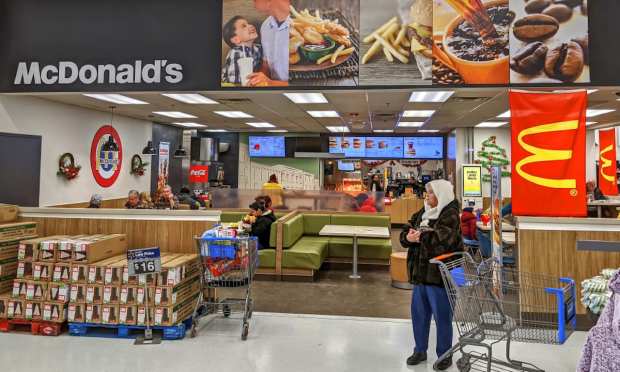McDonald’s Closes In-Walmart Locations, Countering Broader Retail Trends

The COVID-19 pandemic has dramatically changed consumers’ dining habits, as many have grown accustomed to enjoying restaurant meals from the comfort of their own homes where previously they may have dined on-premises. McDonald’s, for one, has seen its drive-thru locations perform significantly higher than its dine-in locations. Now, the quick-service restaurant (QSR) is closing hundreds of its restaurants inside of Walmart stores, though about 150 of these in-Walmart locations will remain open, reported The Wall Street Journal.
At the height of the partnership, which has lasted around 30 years, there were close to 1,000 such locations. Now, given the locations’ reliance on dine-in and their lack of drive-thru windows, these restaurants have seen their sales volume take a dive during the pandemic.
These closures aren’t necessarily an indication that the restaurant-in-superstore model is poorly suited to consumers’ current needs. QSR salad chain Saladworks, for one, recently announced that it would be opening many in-Walmart locations of its own. How these locations perform will give a clearer sense of whether McDonald’s was perhaps premature in these closures, or whether Saladworks would be better served to heed the lessons that the industry veteran learned the hard way.
For McDonald’s, these in-Walmart locations do not fit well into the chain’s Accelerating the Arches growth strategy, which centers on what the company calls the 3 Ds: digital, delivery and drive-thru. While it may seem like this strategy would work better for the height of the pandemic than for the years ahead, as newly vaccinated consumers seek to return to on-premises dining for in-person experiences, the chain has reason to believe that these channels will remain key drivers going forward. On a call with analysts in January, the company’s President and CEO Chris Kempczinski noted that Australia, which had already “done a very nice job of containing the virus” indicated that “channels like digital, like delivery, like drive-thru — they do remain elevated.”
“Those channels … tend to be higher order sizes,” said Kempczinski on the call. “And so as the mix moves to that, I think this idea of [the] elevated check, we’re expecting that that’s going to continue, albeit not at the level that you’re seeing now … There’s going to be a channel mix shift that is going to continue to give benefit to the average check going forward.”
Given the higher spending through these remote channels and given the McDonald’s prediction that demand will remain high for digital orders, it is hardly surprising that the company would close its more on-premises-centric locations. Still, these closures run counter to the broader trends in retail — the store-within-a-store concept is experiencing something of a resurgence amid today’s connected economy, as businesses seek to create integrated experiences that offer consumers access to a wider ecosystem of linked goods and services.
For instance, Starbucks’ locations in Barnes & Noble stores create a compelling consumer journey by welcoming consumers to flip through books in a café environment while sipping a cup of coffee or tea. Similarly, JCPenney’s in-store Sephora shops have allowed the retailer to both attract a younger, more product-savvy beauty consumer, while introducing its core customers to new products and brands. Of course, consumers’ pre-COVID-19 shopping habits are an imperfect predictor, to say the least, of what the future will hold. In-store shops’ performance in the near future will be a key indicator of how consumers’ in-store journeys are evolving into the post-COVID-19 future.